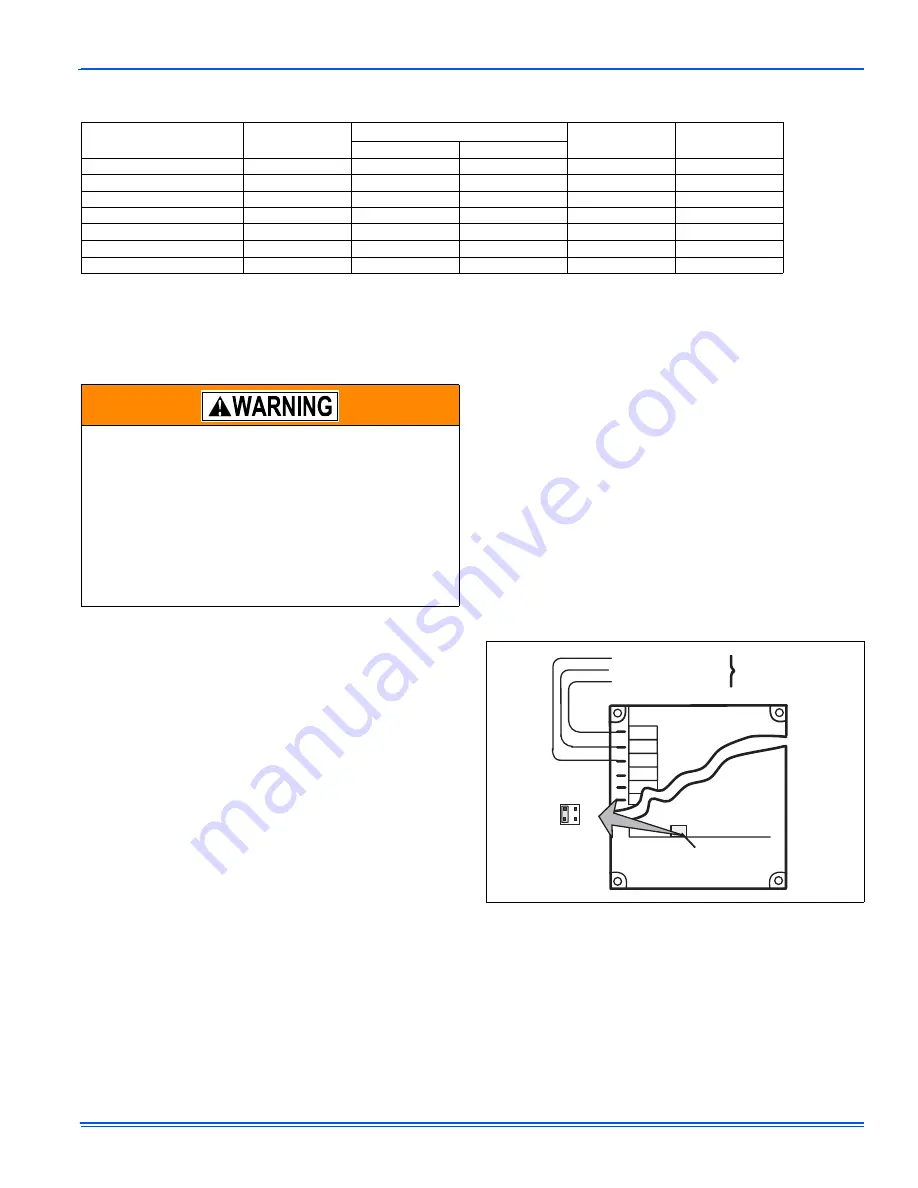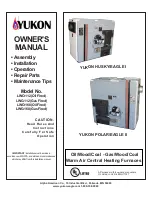
035-19600-001 Rev. B (0204)
Unitary Products Group
5
SECTION II: SERVICE AND MAINTENANCE
MANUAL
SAFETY SECTION
The following safety rules must be followed when servicing the
furnace.
FURNACE MAINTENANCE SECTION
The furnace should be cleaned and adjusted by a certified dealer or
qualified service contractor once a year or before the start of every
heating season. The following items must be cleaned and serviced or
replaced if there are signs of deterioration.
1.
The vent terminal screen (if applicable).
2.
The furnace vent and combustion air intake passageways. Should
it be necessary to service the vent/air intake system, the manufac-
turer recommends this service be conducted by a qualified service
agency. The operation of this appliance requires the reassembly
and resealing of the vent/air intake system.
3.
The furnace burners, ignitor and flame sensor.
4.
The condensate collection and disposal system. If any disassem-
bly of components containing flue or vent gases is required, a
qualified service agency must perform the service.
SEQUENCE OF OPERATION
The following describes the sequence of operation of the furnace. Refer
to Figure 1 for component location.
Continuous Blower
Cooling/heating thermostats have a fan switch that has an ON and
AUTO position. In the ON position the thermostat circuit is completed
between terminals R and G. The motor will operate on the speed tap
wire that is connected to the cooling terminal on the control board. To
obtain a constant air circulation at lower flow rate, change the high-
speed wire to either the medium speed wire or the low speed wire.
Intermittent Blower - Cooling
Cooling/heating thermostats have a fan switch that has an ON and
AUTO position. In the AUTO position the thermostat circuit is completed
between terminals R and G when there is a call for cooling. The motor
will operate on the speed tap wire that is connected to the cooling termi-
nal on the control board. The fan off setting is fixed at 60 seconds to
improve cooling efficiency.
Heating Cycle
When the thermostat switch is set on HEAT and the fan is set on AUTO,
and there is a call for heat, a circuit is completed between terminals R
and W of the thermostat. When the proper amount of combustion air is
being provided, the pressure switch will close, the ignition control pro-
vides a 17-second warm-up period, the gas valve then opens, the gas
starts to flow, ignition occurs and the flame sensor begins its sensing
function. The blower motor will energize 30 seconds after the gas valve
opens, if a flame is detected. Normal furnace operation will continue
until the thermostat circuit between R and W is opened, which causes
the ignition system and gas valve to de-energize and the burner flames
to be extinguished. The vent motor will operate for 15 seconds and the
blower motor will operate for the amount of time set by the fan-off delay
jumper located on the control board. See Figure 7. The heating cycle is
complete, and ready for the start of the next heating cycle.
If the flame is not detected within 2 seconds of the gas valve opening,
the gas valve is shut off and a retry operation begins. If the flame is lost
for 2 seconds during the 10-second stabilization period, the gas valve is
shut off and a retry operation begins. During a retry operation, the vent
motor starts a 15 second inter-purge and the ignitor warm-up time is
extended to 27 seconds. If the flame is established for more than 10
seconds after ignition during a retry, the control will clear the ignition
attempt (retry) counter. If three retries occur during a call for heat, the
furnace will shut down for one hour. If at the end of the one hour shut
down there is a call for heat, the furnace will initiate a normal start cycle.
If the problem has not been corrected the furnace will again lockout
after three retries.
TABLE 1:
Filter Sizes
Input / Output
BTU/H (kW)
CFM (cm/m)
Cabinet Size
Filter Size (in)
Filter Size (cm)
(in)
(cm)
40/37 (11.71/10.84)
1000 (28.32)
14 1/2" (A)
36.83 (A)
14 x 20
35.6 x 50.8
60/55/ (17.57/16.10)
1000 (28.32)
17 1/2" (B)
44.45 (B)
14 x 20
35.6 x 50.8
80/75/ (23.42/21.96)
1200 (33.98)
17 1/2" (B)
44.45 (B)
14 x 20
35.6 x 50.8
80/75/ (23.42/21.96)
1600 (45.31)
21" ( C )
53.34 (C)
14 x 20
35.6 x 50.8
100/95 (29.28/27.82)
1400 (39.64)
21" ( C )
53.34 (C)
14 x 20
35.6 x 50.8
100/95 (29.28/27.82)
2000 (56.63)
21" ( C )
53.34 (C)
14 x 20
35.6 x 50.8
120/112/ (35.14/32.80)
2000 (56.63)
24 1/2" (D)
64.77 (D)
14 x 20
35.6 x 50.8
ELECTRIC SHOCK, FIRE OR EXPLOSION HAZARD
Failure to follow safety warnings exactly could result in
dangerous operation, serious injury, death or property
damage.
Improper servicing could result in dangerous operation,
serious injury, and death or property damage.
•
Before servicing, disconnect all electrical power to the fur-
nace.
•
When servicing controls, label all wires prior to discon-
necting. Reconnect wires correctly.
•
Verify proper operation after servicing.
FIGURE 7:
Typical Heat/Cool Speed Tap Connections
RED-LOW SPEED
BLU-MEDIUM SPEED
BLK-HIGH SPEED
MOTOR LEADS
BLK
BLU
RED
60
180
120
FAN OFF
ADJUSTMENT
SWITCHES
COOL
HEAT
PARK
PARK
LINE
XM
90








































